AKG CK12 (ck12 brass capsule) general info
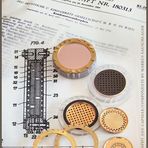
Patent AKG CK12 brass capsule
Markus Sauschlager
A Legend...
The original Austrian CK12 capsules are treasured worldwide for their unique and effortless/smooth sound reproduction quality that flatters almost any musical instrument. They were used as key ingredient in some of the finest, most expensive recording microphones made to this day (AKG C12; C24; ELA M251; ect.) and are still regarded as the holy grail of condenser capsules by many.
Ultimate sound quality achieved through highest precision and special know-how - Made in Austria
The manufacturing of the genuine Ck12-brass capsule is very challenging:
It´s single components consist of solid brass and PMMA. They are machined on a high precision lathe and joined together via fine pitched threads that go around the perimeter of each backplate component. This rigid construction ensures highest durability of the backplate assembly for many decades as it doesn´t rely just on glue.
The diaphragms are attached to solid brass rings that are mounted to each backplate with twelve M1 brass screws.
The two resulting system halves are joined to a complete capsule via three M1,4 screws.
The original CK12 capsule contains 334 precision drilled holes - diameters ranging from 0,8 to 1,6 millimeters. The total diameter is 33,50 millimeters, about the size of a lady´s wristwatch.
The diaphragm material used in the CK12 changed several times over its production period of nearly 30years. The capsule was originally designed to operate with diaphragms made of Styroflex film of ca.10µm thickness and 26mm diameter. But the material became brittle within few years and proved to be unsuitable. When Polyester film (namely "Mylar" by Dupont) appeared on the market in the mid 1950´s the ideal material was found. The subsequent polyester diaphragms had a thickness of ca. 9µm and 25mm diameter. When Mylar became available in 6µm the diaphragms changed once again to this thinner gauge film (also 25mm dia.).
With the change of diaphragm thickness also the backplate was updated too in order to complement the differences in diaphragm mass and vibration characteristics.
By the late 1950´s backplate properties were once changed for another reason too: Broadcast companies were asking for better S/N ratio of the C12. This was accomplished by increasing the backplate´s airchamber depth from 0,2mm to approx. 0,6mm, which resulted in higher signal output of the capsule. As a side effect the frequency response was not flat anymore but showed a slight rise in the presence range and drop in the highest frequencies. Although this was not originally intended it gave the CK12 capsule it´s famous brightish sound that works so well for vocal recording. With the use of 6µm diaphragms this presence bump was evened out a bit and top end performance improved.
-
In Austria we refer to this microphone capsule as "geschraubte CK12" ("screwed CK12") to distinguish it from it´s successor - the "Nylon CK12" - which features a very different construction and sonic signature while still maintaining the same product designation "CK12". Internationally the original design is best known as the "brass ck12 capsule" because of the shiny broad brass rings that hold the diaphragms.
Those rings were invented by AKG already for the predecessor of the CK12 and were a first in capsule design. Previous condenser capsules had the diaphragms glued directly to the backplate. This led to inconsistent diaphragm spacing due to the slightly varying thickness of the glue layer. So this AKG invention was utterly "inspiring" for the Neumann company which quickly implemented such diaphragm holding rings in their own capsule designs (the K53 and later K47 and K67).
The CK12 capsule was also the first to use the dual-backplate design. It was invented to achieve constant sound balance for all polar patterns. Again, Neumann found great use for that AKG invention by designing their K67 capsule.
-
The skill and know-how for making the CK12 brass capsule in it´s original superbness is still kept alive in Vienna to the present day, but the manufacturing cost is prohibitive. It is very expensive to ensure tightest tolerances and impeccable workmanship at each stage which is substantial for predictable sonic excellence and reliability that lasts half a century or more. According to Mr. Wolf this was the reason why AKG stopped to use the brass CK12 in regular production microphones by the late 1970ies. Sadly the manufacturing process can hardly benefit from todays modern CNC technology as many steps have to be done by hand and require specific skills, time and experience - just like an exquisite mechanical watch.
The last regular production model that contained the brass capsule was the AKG C414EB.
The pictured capsule was custom-made in July 2012 by Markus Sauschlager in Vienna, Austria using the traditional manufacturing techniques. More about that project here:
https://at.linkedin.com/in/sauschlager
For those who cannot afford an immaculate original today, replicas and simplified interpretations of this capsule are available from different vendors from all over the world in various price ranges and quality. Unfortunately the designation "CK12" along with "historically correct" is used very loosely to promote imitations which might mislead even the educated customer.
Over the years many original vintage CK12-capsules have been "restored" (read: repaired) abroad without the full specific know-how and skill needed, resulting in changes of vital sound shaping factors. They are usually resold as "original". This makes it increasingly difficult to get hold of the real deal today.
In summer 2017 the AKG GmbH Vienna was shut down by Harman International. Harman now uses the "AKG" brand name to market copies of original AKG products made in Hungary and China without the experience and expertise of the original AKG employees.
The actual Austrian AKG-staff formed a new company called "Austrian Audio", founded by Martin Seidl. Austrian Audio carries on the heritage of Austrian Pro-Audio excellence in Vienna.
In March 2019 "Austrian Audio GmbH" introduced a new incarnation of the classic CK12 capsule - named "CKR12" and presented it at Musikmesse Frankfurt in April 2019. The new CKR12 closely resembles the acoustics of the original old brass CK12 capsule including the hole pattern in the backplate. Also the mechanical construction has been upgraded.
The new CKR12 features a newly designed ceramic enclosure with integrated elastic suspension.
The Austrian Audio CKR12 is built by the same experienced hands that already made countless CK12 capsules at AKG Vienna since 1996 and it certainly outperforms the Harman Nylon capsules offered today.
The CKR-12 can be considered the next best thing to the new, authentic Austrian made Brass-CK12 capsule reissue that´s far more expensive to manufacture and only available upon special request directly from Markus Sauschlager, Vienna.
Unlike the Austrian Audio CKR12, this remanufactured new Brass CK12 is not a serial production model but an individually handcrafted custom capsule that is worthy as top quality spare part for valuable vintage AKG microphones and is also the heart of the new C12/SM204 historic reissue microphones made in Vienna - see this link:
https://www.fotocommunity.de/photo/austrian-c12-reissue-2018-markus-sauschlager/40749228
! EDIT 2022 - Brass CK12 reissue discontinued !
-
The above photograph was shot in 2013 to commemorate the 60th anniversary of the CK12 capsule and to pay homage to it´s inventor Mr. Konrad Wolf and his extraordinary innovative spirit and achievement that has inspired many mic-manufacturers ever since.
The two light sources were LED-spots.
A CK12-blueprint from 1956 was used as backdrop.
The picture was shot through a vintage German Meyer-Görlitz lens.
-- Text and photographs copyright Markus Sauschlager --

AKG C12 - Siemens SM204/23
Markus Sauschlager

AKG C12A tube condenser microphone
Markus Sauschlager
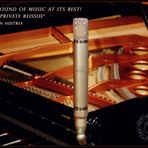
Austrian made C12 reissue 2018
Markus Sauschlager
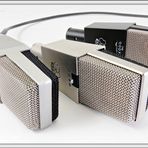
AKG C414
Markus Sauschlager
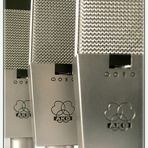
AKG C414EB Condenser microphone
Markus Sauschlager
Additional information about this famous sound transducer can be found here:
http://recordinghacks.com/microphones/tag/ck12
CK12-inspired aftermarket capsules commercially available today include:
Campbell CT12 by Tim Campbell, Denmark: http://www.timcampbell.dk/index2b.htm
Heiserman HK12 by Eric Heiserman, USA: http://www.heisermanaudio.com/store/p1/Heiserman_HK12_Capsule.html
Beesneez CK12 by Ben Sneesby, Australia: https://www.beesneezmicrophones.com.au/store/beesneez-ck12-microphone-capsule.html
-------------------
Die Mikrofonkapsel AKG CK12 besteht auschließlich aus Drehteilen und ihre Herstellung ist äusserst anspruchsvoll. Die einzelnen Komponenten sind mit Feingewinden ineinander geschraubt, die Membranringe sind mit je 12Stk. M1-Schrauben befestigt. Die Kapsel besteht aus zwei Hälften die durch drei M1,4-Schrauben zusammengehalten werden (hierzulande wird sie auch als "geschraubte" CK12 bezeichnet). Sie enthält insgesamt 334 präzise Bohrungen (Durchmesser 0,8mm - 1,6mm)
Bei einem Gesamtdurchmesser von 33,50mm hat sie etwa die Größe einer Damen-Armbanduhr.
Wegen der markanten Membranhalteringe aus Messing wird sie international auch oft als "CK12 brass capsule" bezeichnet.
Das Membranmaterial wurde über den ca. 25-jährigen Produktionszeitraum der CK12-Kapsel mehrmals geändert. Die ursprünglich verwendete Styroflexfolie mit 10µm Stärke erwies sich als unbrauchbar da sie schon nach kurzer Zeit spröde wurde. Als schließlich Polyesterfolie erhältlich wurde war das ideale Membranmaterial gefunden. Zunächst wurde eine Stärke von 9µm verwendet. Schließlich wurde das Material auch in 6µm angeboten und die Membranen wurden abermals auf die dünnere Folie umgestellt.
Höchste Klangqualität durch höchste Präzision - Made in Austria
Die Wiener AKG GmbH wurde im Juni 2017 von Harman International für immer geschlossen. Harman verwendet den Markennamen "AKG" um in Ungarn und Fernost gefertigte Kopien der produkte aus dem AKG-Sortiment zu vermarkten.
Die Wiener AKG-Mitarbeiter formierten sich zu dem von Martin Seidl neu gegründeten Unternehmen Austrian Audio GmbH. Damit ist Austrian Audio in der Lage das Erbe und den innovativen Geist der Firma AKG in Wien fortzuführen.
Im März 2019 wurde von Austrian Audio die CKR12 Kapsel vorgestellt - eine akustisch sehr enge Verwandte der geschraubten alten CK12 brass Kapsel. Gegenüber der Nylon CK12 wurde außerdem das Kapselgehäuse neu entwickelt, welches nun aus schwarzer Keramik besteht. Die CKR12 wird von den gleichen erfahrenen Händen gebaut die schon zuvor bei AKG in der CK12-Fertigung wirkten.
Die neue Austrian Audio CKR-12 ist in vielerlei Hinsicht der aktuellen Harman-AKG Nylon Kapsel überlegen und wohl die nächstbeste Alternative zur viel teureren geschraubten Brass CK12.
Anlass für dieses Foto war das 60-jährige Jubiläum dieses Schallwandlers.
Die Kapsel wurde erstmals im 1953 erschienenen Röhrenmikrofon AKG C12 eingesetzt. Das letzte Mikrofon mit dieser Kapsel war das AKG C414EB (bis in die späten 1970er jahre).
Zur Beleuchtung dienten zwei LED-Lampen
Im Hintergrund ist eine techn. Zeichnung der Kapsel aus dem Jahr 1956 zu sehen
Weitere Informationen zu dieser berühmten Mikrofonkapsel gibt es hier:
http://recordinghacks.com/microphones/tag/ck12
Heute erhältliche Nachbauten der AKG CK12 sind u.a.: Tim Campbell CT12, Eric Heiserman HK12, Beesneez CK12
Image is copyright-registered at: https://www.creativdepot.at/document/9349157451.pdf
#AKGck12brass ; #brassck12capsule ; #CampbellCT12 ; #HeisermanHK12 ; #BeesneezCK12 ; #AustrianAudio ; #CKR12 ; #MarkusSauschlager
-
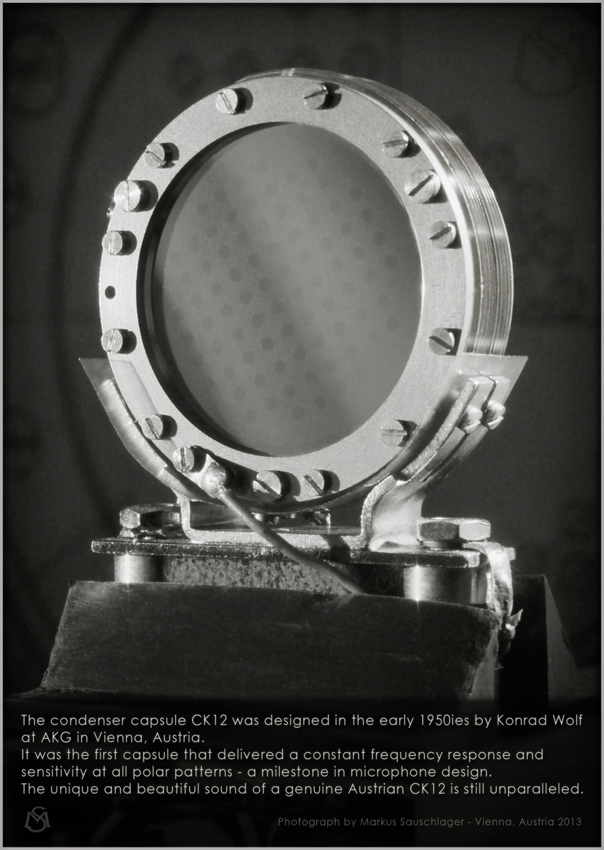










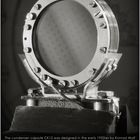
Kommentare 0
Kommentar löschen
Kommentar und Antworten löschen